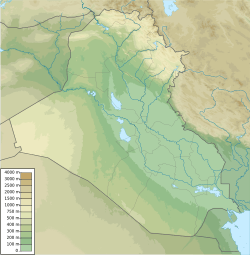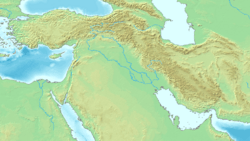Hadji Muhammed facts for kids
| Alternative name | Hadji Muhammed, Haggi Muhammad |
|---|---|
| Location | Al Muthanna Governorate, Iraq |
| Region | Lower Mesopotamia |
| Coordinates | 31°19′27.77″N 45°38′11.47″E / 31.3243806°N 45.6365194°E |
| Type | archaeological site, tell, type site |
| History | |
| Periods | Ubaid period |
| Site notes | |
| Excavation dates | 1937–1939 |
| Archaeologists | {{#statements:P4345}} |
Hadji Muhammad is an important archaeological site in Southern Iraq. An archaeological site is a place where people lived long ago, and we can find clues about their lives. This site is so special that it gave its name to a unique style of pottery. It also represents an early part of the Ubaid period, a very old time in history.
Contents
What is Hadji Muhammad?
Hadji Muhammad is a type of archaeological site called a tell. A tell is a mound that forms over many years. It happens when people build new homes on top of old ones. This creates layers of history, like a giant cake. Archaeologists dig through these layers to learn about the past.
The Ubaid Period
The Ubaid period was a time in ancient Mesopotamia, which is now Iraq. It lasted from about 6500 to 3800 BC. During this time, people started to live in larger villages. They also began to farm using irrigation. This period was very important for the development of early civilizations.
Special Pottery
The pottery found at Hadji Muhammad is very famous. It has a special style that helps archaeologists understand the Ubaid period.
Pottery Design
The pottery is painted with dark colors like brown, black, or purple. It features attractive geometric patterns. These patterns are made of shapes and lines. This style is unique to the Hadji Muhammad phase.
Where it Fits in History
This pottery style comes between two other important periods. It is after the earliest settlements at Eridu. It is also before the "classical" Ubaid style. This means it helps us see how the Ubaid culture changed over time. This pottery has been found in places as far north as Ras Al-Amiya.
Life in Hadji Muhammad
People living in the Hadji Muhammad period made important advancements. They changed how they farmed and built their homes.
Canal Networks and Farming
During this time, people started to build large networks of canals. These canals helped them bring water to their farms. This is called irrigation agriculture. It allowed them to grow more food.
Irrigation farming first developed at a place called Choga Mami around 4700–4600 BC. It quickly spread to other areas. Building and maintaining these canals needed many people to work together. It also required someone to organize the work. This shows that people were starting to live in more organized communities.
Building Homes
The buildings in Hadji Muhammad were made from simple materials. They used wattle and daub or mud brick.
- Wattle and daub is a building method using woven branches (wattle) covered with a mix of mud, clay, sand, and straw (daub).
- Mud brick is made from mud mixed with straw, then dried in the sun. These materials were easy to find and use.
A Theory About the Pottery
A famous archaeologist named Joan Oates studied the pottery from this period. She suggested something interesting about the pottery styles. Even though some pots looked different, she thought it might just be a change in fashion. She believed it was not a sign of a completely new culture. This means the people might have been the same, but their pottery styles evolved.



